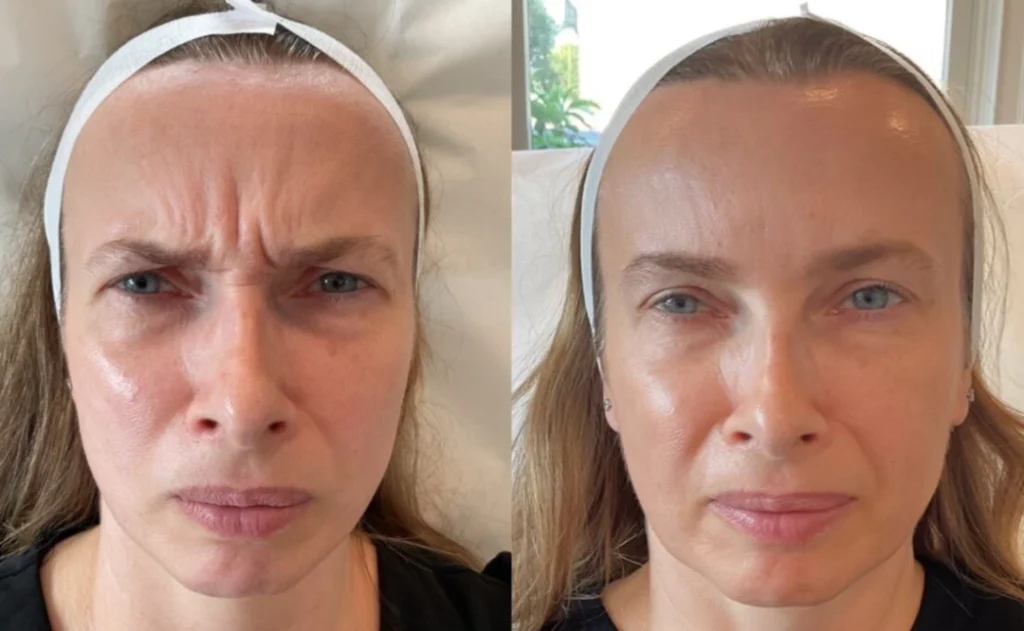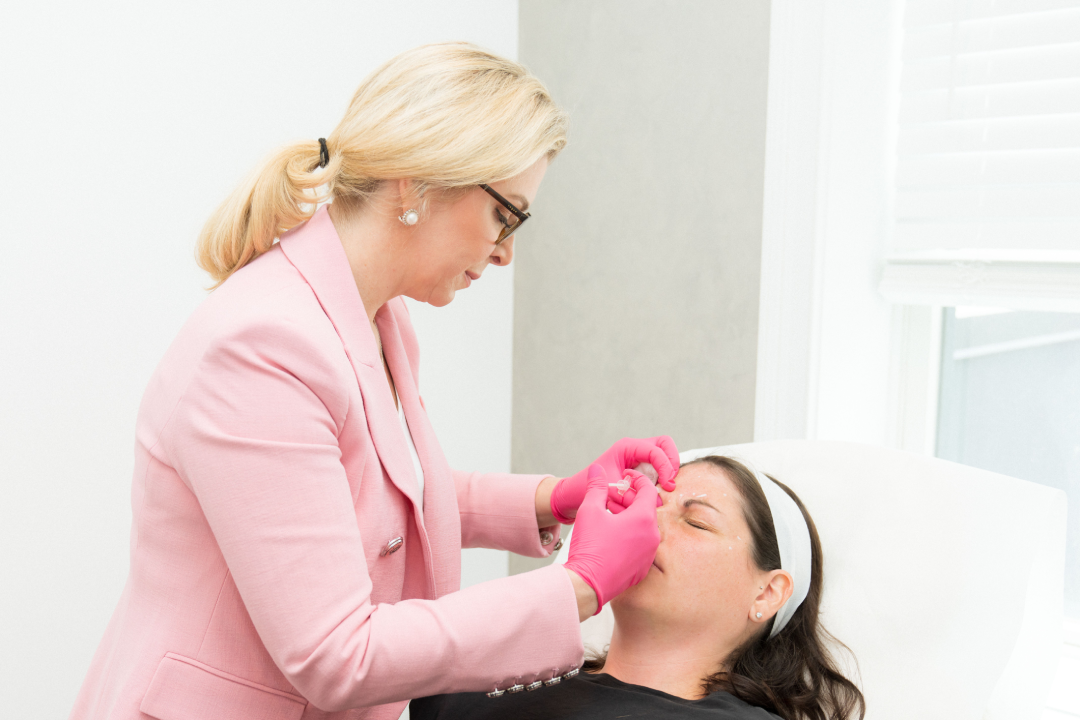Wrinkles have a way of sneaking up on us. One day, it’s smooth sailing; the next, a line seems to have set up camp between your brows. The good news? We know a lot more about how and why these lines form—and, more importantly, how to soften them.
Wrinkle relaxers, like Botox®, Dysport®, and Xeomin®, use botulinum toxin to temporarily relax the muscles responsible for those expression lines. But these customized treatments aren’t one-size-fits-all. Different areas of the face need different approaches to achieve smooth, natural-looking results.
In this blog, we’ll break down the most common treatment areas, why wrinkles show up there in the first place, and how these targeted injections help turn back the clock—without freezing your expressions or making you look like someone else.
How Wrinkle Relaxers Work: The Science Behind the Smooth
Wrinkles form when we repeatedly use facial muscles to express ourselves—like raising an eyebrow, laughing at a joke, or squinting at a screen. Over time, these movements crease the skin, especially as collagen production slows with age.
Botox® and other advanced neuromodulators like Dysport® and Xeomin® step in by temporarily blocking nerve signals to the targeted muscles. When the muscles relax, the skin above them smooths out. The result? Softer, more youthful-looking skin without changing the way you naturally express yourself.
Botox® vs. Dysport® vs. Xeomin®: What’s the Difference?
While all three products use botulinum toxin type A, their formulations and how they work in the skin differ:
- Botox®: Contains botulinum toxin type A with protective proteins, offering precise and reliable results. Often the first choice for smaller areas like frown lines or crow’s feet.
- Dysport®: Has a different protein composition that allows it to diffuse more easily, making it ideal for larger areas like the forehead. It also tends to work a little faster.
- Xeomin®: A purified form of botulinum toxin type A without accessory proteins, which may help reduce the risk of resistance over time. It delivers similar results to Botox® but appeals to those looking for a more simplified formula.
Targeting Specific Facial Areas with Wrinkle Relaxers
Wrinkle relaxers aren’t one-size-fits-all. Here’s a breakdown of the most common treatment areas and how Botox® or Dysport® can help.
1. Frown Lines (Glabellar Lines or “11s”)
Frown lines show up between the eyebrows after years of squinting or concentrating. Over time, they can give your face a permanently tense appearance.
How Wrinkle Relaxers Help:
- Relaxing the corrugator and procerus muscles softens the lines without impacting brow movement.
The Result: A more approachable, relaxed look—even when you’re focused.

2. Crow’s Feet (Lateral Canthal Lines)
These fine lines appear around the outer corners of the eyes, thanks to years of smiling, squinting, and living life.
How Wrinkle Relaxers Help:
- By targeting the orbicularis oculi muscles, these treatments soften the lines while preserving the warmth of your smile.
The Result: Eyes that look refreshed, not frozen.
3. Forehead Lines (Horizontal Wrinkles)
Those horizontal lines across your forehead? They’re usually the result of raised eyebrows from surprise, curiosity, or years of asking, “Wait, what?”
How Wrinkle Relaxers Help:
- Injections into the frontalis muscle soften these lines while maintaining natural movement.
- Dysport® may be preferred for larger foreheads due to its broader diffusion.
The Result: A smoother, more relaxed forehead that still lets you look surprised—when you need to.

4. Bunny Lines (Nasal Wrinkles)
When you laugh, sniff, or scrunch your nose, small lines can form on either side of the nasal bridge.
How Wrinkle Relaxers Help:
- A few units injected into the nasalis muscle smooth these wrinkles without affecting natural expressions.
The Result: A smoother nasal area without that scrunched-up look.
5. Lip Lines & Lip Flip (Perioral Wrinkles)
Fine vertical lines around the mouth—sometimes called “smoker’s lines”—can appear from talking, laughing, and sipping through straws.
How Wrinkle Relaxers Help:
- Small doses relax the muscles around the lips, softening wrinkles.
- A lip flip involves injecting Botox® near the upper lip to subtly roll it outward for a fuller appearance.
The Result: Smoother lips and a naturally enhanced shape.
6. Chin Dimpling (Mentalis Strain)
A dimpling or “orange peel” effect on the chin often appears when the mentalis muscle is overactive.
How Wrinkle Relaxers Help:
- Relaxing the mentalis muscle smooths the skin and softens dimples.
The Result: A more refined, youthful chin area.
7. Jawline Slimming & TMJ Relief (Masseter Botox®)
Enlarged masseter muscles often cause an overly prominent jawline or chronic jaw clenching.
How Wrinkle Relaxers Help:
- Injections into the masseter muscles reduce muscle activity, slimming the jawline and alleviating TMJ symptoms like jaw tension and headaches.
The Result: A slimmer, more sculpted jawline and less jaw discomfort.
8. Neck Bands (Platysmal Bands)
Vertical lines in the neck can become more visible with age or frequent downward gazing (hello, smartphones).
How Wrinkle Relaxers Help:
- Targeting the platysma muscles relaxes these bands and softens the neck’s appearance.
The Result: A smoother, more youthful-looking neck.
What to Expect During and After Treatment
If you’re new to wrinkle relaxers, here’s a quick overview of what happens:
- Your Consultation: Before treatment, you’ll have a personalized consultation to discuss your goals and determine which wrinkle relaxer—Botox®, Dysport®, or Xeomin®—is best suited for you.
- The Treatment: Injections typically take 10–20 minutes, depending on the treatment area. Most people describe the sensation as a quick pinch.
- Aftercare Guidelines: No rubbing or massaging the treated areas for the first 24 hours. Avoid strenuous exercise and keep your head upright.
- When Results Appear: Dysport® results often start to become noticeable within 2–3 days, while Botox® typically begins to show within 4–7 days. Xeomin® falls somewhere in between, with results usually appearing around 3–4 days. However, full results for all three treatments typically take 10–14 days to fully develop.
Results generally last about 3–4 months, depending on the treatment area, muscle activity, and individual factors.
Which Wrinkle Relaxer Is Right for You?
Botox®, Dysport®, and Xeomin® are highly effective wrinkle relaxers, but the best choice depends on factors like the treatment area, muscle strength, and your individual goals.
Each product has its own nuances—Botox® is often chosen for smaller, more defined areas, while Dysport® may be preferred for larger areas like the forehead. Xeomin®, on the other hand, is a purer formulation without accessory proteins, which may be beneficial for those who have developed a resistance to other neuromodulators.
The goal isn’t just fewer wrinkles—it’s achieving natural, balanced results that enhance your features while preserving your unique expressions. Your injector’s expertise plays a key role here. At Bare Aesthetic in Bergen County, NJ, we take a customized approach, assessing your facial anatomy and understanding the results you’re looking for to recommend the best product for you.
The Bottom Line on Wrinkle Relaxers
Neuromodulators have revolutionized how we approach wrinkles—without surgery or downtime. By targeting specific facial muscles, these treatments soften lines and help maintain a naturally refreshed appearance.
If you’re considering wrinkle relaxers, start by identifying the areas that bother you most. Understanding how these treatments work can help you have a more informed conversation with your provider—and get results that align with your goals.
For more information or to schedule a consultation, visit getbare.com.
All content provided is for informational purposes only and does not constitute medical advice.
All images used are shared with the expressed written consent of the individuals featured.

